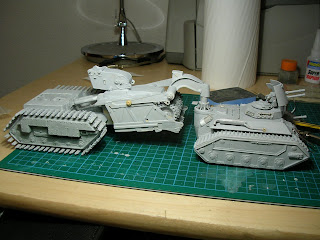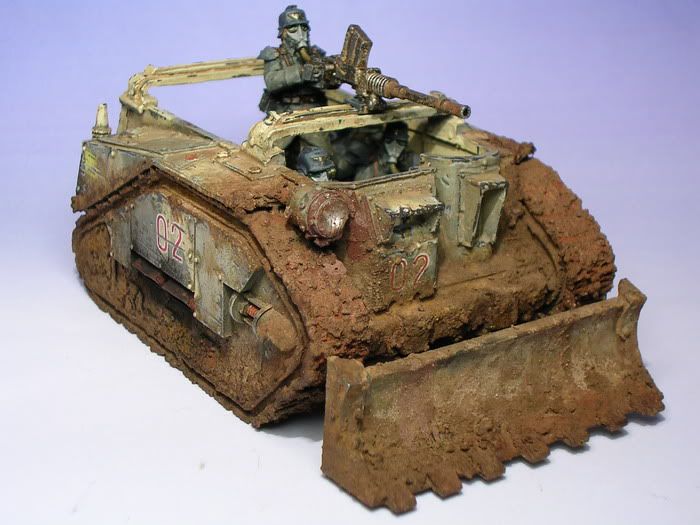(versión en Español)
A lot of modelers have the same problem when facing a Chimera or Leman Russ kit: The tracks does not fit. No matter how much you try or how much you read the instructions, those tracks will not fit properly.
Of course, this is a well known problem, but until Games Workshop develops an alternative track sprue we need to find some solution. There are people that simply leave some missing links in the lower part, where they would not be seen, or that leave them in the upper part, covered by track guards.
As a fellow modeler asked me what I did to solve the problem, I did this quick walkthrough.
First of all, I use polystyrene cement. It allows the pieces to be adjusted after being glued. Cyanoacrylate (superglue) sets too fast for that.
A lot of modelers have the same problem when facing a Chimera or Leman Russ kit: The tracks does not fit. No matter how much you try or how much you read the instructions, those tracks will not fit properly.
Of course, this is a well known problem, but until Games Workshop develops an alternative track sprue we need to find some solution. There are people that simply leave some missing links in the lower part, where they would not be seen, or that leave them in the upper part, covered by track guards.
As a fellow modeler asked me what I did to solve the problem, I did this quick walkthrough.
First of all, I use polystyrene cement. It allows the pieces to be adjusted after being glued. Cyanoacrylate (superglue) sets too fast for that.
 I use the handy sanding pads from Rhino for removing sprue marks. This is important if you want the tracks to be glued to the sides.
I use the handy sanding pads from Rhino for removing sprue marks. This is important if you want the tracks to be glued to the sides. Let's start with those links.
Let's start with those links. I start from the upper front of the track set. As I said before, I glue the tracks mainly to the sides. If a link lies on a wheel, I obviously apply glue to it. But I want the track to be parallel to the sides (If you look closely at the pic below, you would see that the end of the long track section is not in contact with the wheel, but parallel to the side).
I start from the upper front of the track set. As I said before, I glue the tracks mainly to the sides. If a link lies on a wheel, I obviously apply glue to it. But I want the track to be parallel to the sides (If you look closely at the pic below, you would see that the end of the long track section is not in contact with the wheel, but parallel to the side).



 Now it's nearly complete, we only need one of those big tracks sections.
Now it's nearly complete, we only need one of those big tracks sections. Well, we knew it would not fit, isn't it?
Well, we knew it would not fit, isn't it? And this is the trick, it is most probable that there are a lot of people already doing it, but some other would probably find it useful
And this is the trick, it is most probable that there are a lot of people already doing it, but some other would probably find it usefulJust cut the end of the track section like this:
 You will end with a reduced track link.
You will end with a reduced track link. Sand the end a little to give it a rounded shape.
Sand the end a little to give it a rounded shape. And that is. A shorter link at the bottom part of your tracks. Once painted, I assure you that even if you flip your model upside down, you'll need to closely inspect the link to notice that something is wrong.
And that is. A shorter link at the bottom part of your tracks. Once painted, I assure you that even if you flip your model upside down, you'll need to closely inspect the link to notice that something is wrong.













































